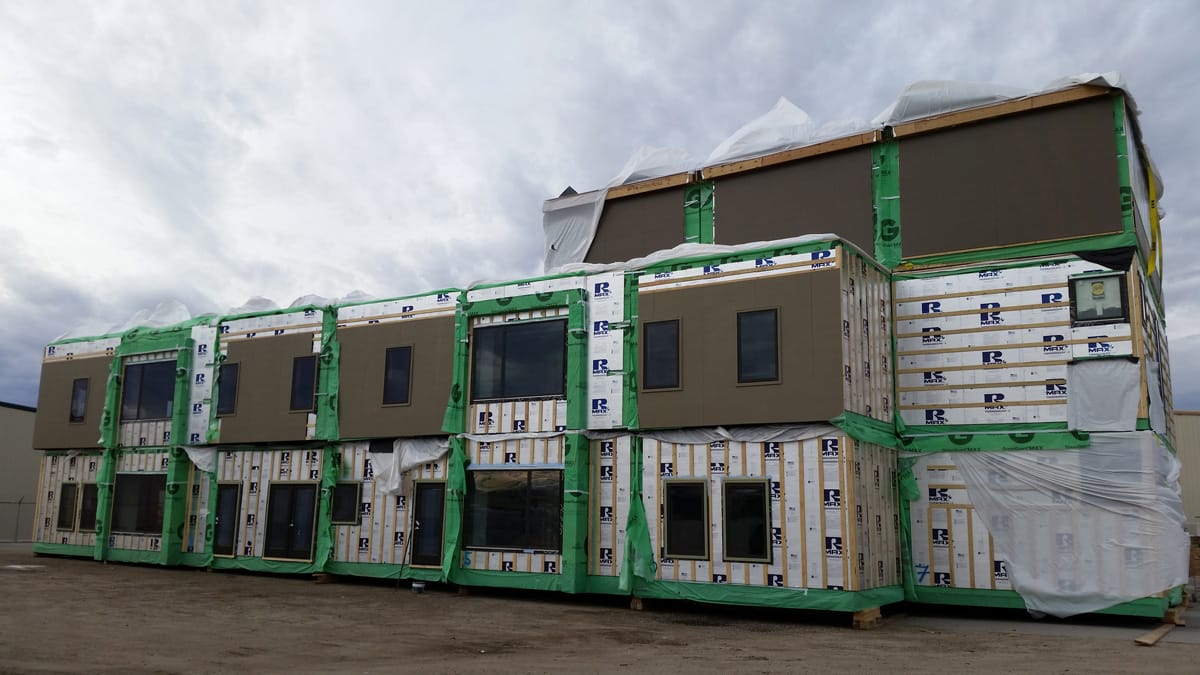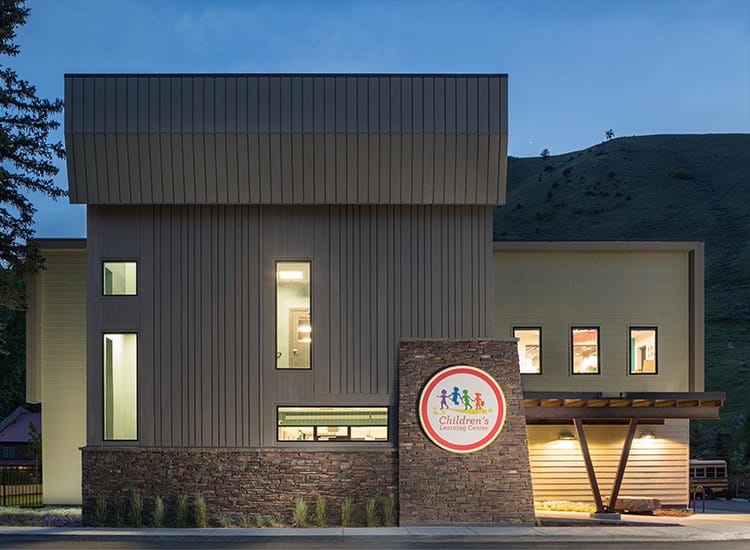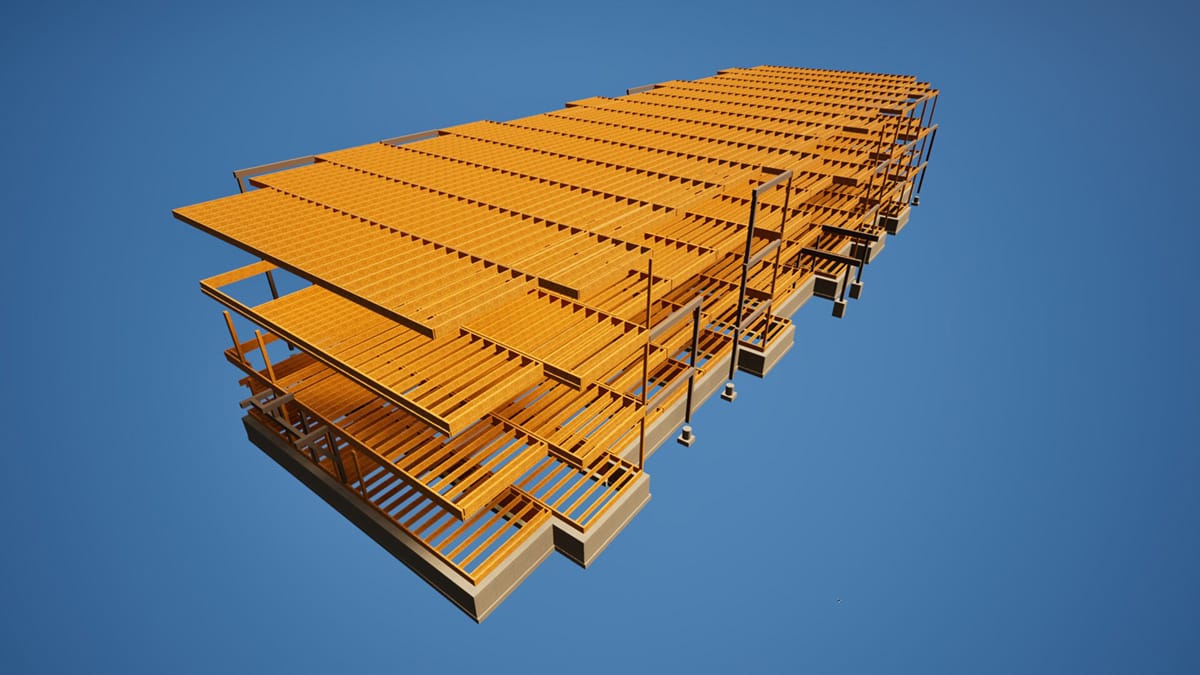Tamarack Grove Engineering: Designing for the Modular Sector
From initial analysis to construction administration, the role of a structural engineer is crucial to a modular project's success. Here’s why.
In 2003, CEO Brian J. Sielaff, P.E., S.E., P. Eng., who had 12 years of structural engineering experience under his belt, worked part-time on a new venture. In 2007 he started full-time with Tamarack Grove Engineering, a structural engineering company in Boise, Idaho. He hired several employees and turned his sole attention to his fledgling company. Then the Great Recession hit.
Once again, Sielaff was the sole employee, but he persevered. In 2011, Doug Hardin, P.E., who at the time was a junior at Boise State University, majoring in civil engineering, accepted an internship at Tamarack Grove. He’s glad he did.
“Since 2011 we’ve continued to grow and have had our best year every year since,” said Hardin, who is now president of Tamarack Grove. “All of it has been organic growth.”

Tamarack Grove provided the structural engineering on this ground up children’s care facility including designing modular aspects and site build portions.
Over the past two years, the company experienced an explosion of growth. Today, it has more than 40 employees. Last fall the company opened new offices in Bozeman, Montana and Lyndhurst, New Jersey.
Hardin attributes the company’s growth to two things: One, having great clients, and two, diversification — both in the breadth of its clients and the type of work the company does.
Tamarack Grove offers structural engineering services — project analysis, plan creation, design creation, and construction administration — for commercial, manufacturing, facilities, public services, and modular. Modular is only one market sector the company serves but it is an increasingly popular one.
The company is also licensed across all 50 states, Washington D.C., the U.S. territories of Guam, Puerto Rico, the Virgin Islands and the Bahamas, as well as nine Canadian provinces.
“That’s allowed us to grow with our clients,” Hardin said. “No matter where their projects are located, we’ve been able to accommodate them.”
A Passion for Modular
Early in his career Hardin got a chance to work on a modular project. It was for a childcare center in Jackson, Wyoming, a location with a short building season.
“That’s where I started to really learn the benefits of modular construction, especially in regard to how it can really speed up the timeframe,” Hardin said. “I became intrigued by modular construction in general. You don’t have to rub shoulders long with folks in the industry to build a passion for modular.”
The Importance of Structural Engineers
Structural engineers are an important asset on any construction project, especially modular ones.
“Modular projects are a bit unique in how they are built,” Hardin said. “Having an engineer with knowledge about modular projects is the key to a successful project.”
The permitting process is one factor that differs between modular and stick construction.
Modular often requires two separate permits — one for building off-site in the factory and another for on-site construction.
How the modules will be constructed is another factor. Each factory has certain preferences for how they manufacture the modules and for the type of material used. With multi-modular projects, the individual modules need to be tied together, which also differs from stick construction.
A structural engineer experienced in modular building can take all these factors into account and avoid future issues. Their value to the project increases the earlier they are brought into the project.

Salvatore Tafuro was introduced by outgoing MBI Board Chair John Buongiorno.
For example, most modular factories use only one building material, typically wood or steel. If the structural engineer knows which company will manufacture the modules, they’ll have a good idea of the material to include in the design early on. The major difference is the type of fasteners used to connect the modules. Wood modular construction relies more on nails and staples. Steel modular construction uses more screws and welds.
In addition, stick construction uses two-by-six studs covered with OSB sheathing, while steel construction may use steel straps for bracing instead of sheathing. Fire ratings also differ according to the building material.
“If we can get involved in a project early enough, we can provide input on cost implications of the materials, as well as the benefits of each, including a fire rating or a height benefit,” Hardin said.
Not only is it important to bring in a structural engineer at the beginning of the project, but it’s also advantageous to keep the same engineer or engineers see the job through from beginning to completion. Why? Efficiency. Continuity of design. Faster completion. There’s no need for an engineer to get up to speed with the project, there’s no duplication of calculations.
“Every engineer has a different thought process on how to accomplish something,” Hardin said. “And during the transfer of information from one engineer to another, there’s the chance some information will be lost or misunderstood.”


Tamarack Grove provided structural calculations for full gravity/lateral load path analysis for all shear wall, floor, and ceiling framing plans, as well as detailing for joists, beams, columns, wall framing, and associated fastener connections for 2, 3-story modular buildings.
Special Concerns
Some modular projects, like a building design in high seismic or high wind areas, call for more detailed analysis. That’s where structural engineers are an invaluable asset. Their analysis will determine what the resisting elements are.
Resisting elements for a modular design are typically the shear walls. Based on where they are located and their height, structural engineers will determine how to get the loads to the shear walls and how to connect the modules to transfer those loads across multiple modules.
For a multi-story modular structure, a structural engineer will determine how to transfer the loads floor to floor and then to the foundations.
Factory or Onsite?
Every modular project begins in the factory and is finished onsite. It’s important to determine what needs to be done where.
The foundation is the main component of onsite construction. Each location requires a foundation based on its specific soil parameters. Items that are attached to the module like awnings or decks are often created onsite as well as steps and walkways.
Sometimes shipping height restrictions is why a component such as a pitched or gable roof is attached onsite rather than being integrated in the factory.
“Everything can be manufactured and shipped at the same time as the modules,” Hardin said. “Speed of construction doesn’t have to slow just because we are adding things onsite.”
Even well-planned modular projects can experience a hiccup along the way. Hardin recalls one job that specified the sheathing and a strip of flooring be applied onsite. They created the design that way so they could strap the modules together in the field, then cover the strapping with the sheathing so the final result would be aesthetically pleasing. But the sheathing and strip of flooring were mistakenly applied to the modules prior to connecting the modules together.
“It created a quicker completion timeline onsite,” Hardin said. “But the problem was that it didn’t allow enough space for the module-to-module connections.”
The entire team — Tamarack Grove, the general contractor, the architect, and the module manufacturer — came together to find a solution. They screwed the modules together at the exposed drop beams with timber screws.
“When all was said and done, you couldn’t see them at all, and we were able to keep what they had done in the factory,” Hardin said. “It ended up being a great process overall, but it was a late in the game change.”
Collaboration is Key
Communication and collaboration are the best place to begin a modular project. Hardin’s first step is to ask questions, so everyone is on the same page.
- What is the intent of the project?
- What are we trying to accomplish?
Other questions are geared toward the preferences of the module manufacturer.
- How do you like to put the modules together?
- What standard details do you prefer to use?
- What materials will you use?
“There’s no point in creating a design that they can’t construct or that will create a hardship for them,” Hardin said. “We try to create a design that is as efficient as possible from all aspects. One of those main aspects is being able to build the module efficiently in the factory. And that’s going to vary according to manufacturer.”
Later, Hardin will discuss the constraints or limitations of the project, whether it’s the size of the modules or the ratings of a two-by-four versus a two-by-six. This will establish the design guidelines, the parameters needed to create a structural design.
Communication is critical even before the project begins. Hardin said owners, users, and financiers must understand the benefits of modular and how they apply to their project.
“Modular is the better mousetrap, but a mousetrap isn’t the solution for everything,” Hardin said. “If you’re trying to catch a rabbit you don’t use a mousetrap.”
The typical questions aimed at him involve cost of shipping versus building everything onsite and the pros and cons of different building materials.
The design team and owner also need to realize that the sooner the project team is established and begins working together, the better. The project will be more cost effective, the design will be completed quicker, the factory process will be streamlined, and the shipping process will be smoother.
“If you have everybody involved in the process early on, the issues can be addressed sooner rather than when it’s almost too late,” Hardin said.
As more structural engineers gain experience with modular construction and all stakeholders truly understand its advantages, modular construction will continue to grow. And that’s good news for everyone!
About the Author: Shari Held is an Indianapolis-based freelance writer who has been covering the construction industry for more than 20 years.
More from Modular Advantage
Resia: Breaking All the Rules
Resia Manufacturing, a division of U.S.-based Resia, is now offering prefabricated bathroom and kitchen components to industry partners. Its hybrid fabrication facility produces more precise bathroom and kitchen components (modules) faster and at lower cost than traditional construction. Here’s how Resia Manufacturing does it.
How LINQ Modular Innovates to Bring Modular To The Market in the UAE and Beyond
LINQ Modular, with an office and three manufacturing facilities in Dubai, is a modular firm based in United Arab Emirates. The company is on a mission: to break open the housing and construction markets in the Gulf Cooperation Council (GCC) area with modular.
ModMax: Redefining Modular Construction with Confidence and Precision
ModMax was born out of frustration—frustration with five persistent pain points in modular construction: Permitting bottlenecks. Production delays. Rigid designs. Disconnect between “the office” and the field. Lack of transparency and communication.
LifeArk: Disaster-Resilient Housing from Recycled Plastic and 100-year-old Technology
Wee compares LifeArk’s housing units to Yeti coolers, as they are built similarly. Each component takes 15 to 20 minutes to manufacture, has an R-value of 40, and includes molded slots and chases for wiring, plumbing, fire sprinklers, and other utilities.
Building the Future of Modular Edge Infrastructure
The edge data center market is expanding rapidly, driven by the surge in AI workloads, IoT adoption, and the need for localized compute power. In these environments, sustainability, scalability, and reliability are non-negotiable. Cooling is among the most complex challenges for operators—and one of the most decisive factors in long-term success.
Accelerating Light-Gauge Steel Construction: A Semi-Automated Digital Workflow for Off-Site Projects
For construction professionals, the message is clear. By adopting semi-automation and digitalization, companies can deliver projects faster, more accurately, and more profitably, while also building stronger collaboration across teams. The approach is not about replacing people with machines, but about empowering people with better tools and processes.
Why Modular Data Centers Are Gaining Momentum
Artificial intelligence, high-performance computing, and edge applications push the limits of traditional “stick-built” data centers. They take years build, often struggle with high density workloads, and aren’t optimized for deployments near end users. Modular data center platforms are purpose-built to address these challenges, offering flexibility and scalability to adapt to evolving technologies, while opening new opportunities for the modular construction industry.
Supply Chain Innovation in Action: 5 Habits Every Modular Leader Should Practice
By applying these principles to supply chain practices — collaborative planning, strategic procurement, scenario modeling, digital tools, and transparent forecasting — construction leaders can build value chains that are not just efficient and agile, but truly innovative.
Exploring the Role of Modular Integrated Construction (MiC) in Advancing Circular City Principles – A Survey of Stakeholder Perspectives
The survey findings highlight the significant potential of Modular integrated Construction (MiC) in advancing the development of circular cities. By reducing costs, accelerating construction timelines, and minimizing waste generation, MiC offers a promising approach to sustainable urban development.
The Use of MS POLYMER™-Based Sealants and Adhesives in Modular Building
These products combine flexibility and elastic recovery with excellent adhesion to different substrates and have already shown their usefulness in traditional construction. Now it’s time for them to be put to use in the modular construction industry.










